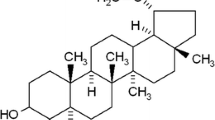Abstract
Objective
To study the combined antitumor effect and possible mechanisms of ursolic acid with 5-fluorouracil (5-FU) on human esophageal carcinoma cell Eca-109 in vitro.
Methods
Eca-109 cells were treated with ursolic acid (10–50 μmol/L) and/or 5-fluorouracil (48.0–768.8 μmol/L) for 48 h in vitro. And then cell proliferation was determined by MTT assay. Cell cycle and apoptosis rate were analyzed by flow cytometry (FCM). The morphological changes of apoptosis were observed by fluorescent microscopy. At last the expression of P27kip1, bcl-2 and bax were detected by western blot.
Results
In comparison with single agent treatment, the combination of ursolic acid and 5-fluorouracil produced greater efficacy in growth inhibition, cell cycle arrest at G0/G1 phase, and apoptosis induction (P<0.05). Western blot analysis showed that the combination use of ursolic acid and 5-fluorouracil suppressed the expression of bcl-2 and increased the expressions of bax and P27kip1.
Conclusion
Ursolic acid combined with 5-fluorouracil showed adjuvant antiproliferative effects on human esophageal carcinoma cell Eca-109 in vitro, which mainly due to the induction of cell cycle arrest as well as apoptosis.
Similar content being viewed by others
References
Ali MS, Ibrahim SA, Jalil S, et al. Ursolic acid: a potent inhibitor of superoxides produced in the cellular system [J]. Phytother Res 2007; 21: 558–561.
Rana VS, Rawat MS. A new xanthone glycoside and antioxidant constituents from the rhizomes of Swertia speciosa [J]. Chem Biodiver 2005; 2:1310–1315.
Manu KA, Kuttan G. Ursolic acid induces apoptosis by activating p53 and caspase-3 gene expressions and suppressing NF-kappaB mediated activation of bcl-2 in B16F-10 melanoma cells [J]. Int Immunopharmacol 2008; 8:974–981.
Pathak AK, Bhutani M, Nair AS, et al. Ursolic acid inhibits STAT3 activation pathway leading to suppression of proliferation and chemo-sensitization of human multiple myeloma cells [J]. Mol Cancer Res 2007; 5:943–955.
Bonaccorsi I, Altieri F, Sciamanna I, et al. Endogenous reverse transcriptase as a mediator of ursolic acid’s anti-proliferative and differentiating effects in human cancer cell lines [J]. Cancer Lett 2008; 263:130–139.
Ismaili H, Sosa S, Brkic D, et al. Topical anti-inflammatory activity of extracts and compounds from Thymus broussonettii [J]. J Pharm Pharmacol 2002; 54:1137–1140.
Chen GQ, Shen Y, Duan H. Anti-tumor effect and its mechanisms of ursolic acid on human esophageal carcinoma cell Eca-109 in vivo [J]. Chin J Cancer Res 2008; 20:205–210.
Scartozzi M, Galizia E, Verdecchia L, et al. Chemotherapy for advanced gastric cancer: across the years for a standard of care [J]. Expert Opin Pharmacother 2007; 8:797–808.
von Minckwitz G. Docetaxel/anthracycline combinations for breast cancer treatment [J]. Expert Opin Pharmacother 2007; 8:485–495.
Thompson CB. Apoptosis in the pathogenesis and treatment of disease [J]. Science 1995; 267: 1456–1462.
Kirkin V, Joos S, Zornig M. The role of Bcl-2 family members in tumorigenesis [J]. Biochim Biophys Acta 2004; 1644:229–249.
Shibata H, Matsubara O, Wakiyama H, et al. The role of cyclin-dependent kinase inhibitor p27 in squamous cell carcinoma of the esophagus [J]. Pathol Res Pract 2001; 197:157–164.
Author information
Authors and Affiliations
Corresponding author
Additional information
This work was supported by the grants from the Natural science Foundation Project of Chongqing Sci & Tech Committee (CSCT, 2006BB5297).
Rights and permissions
About this article
Cite this article
Chen, Gq., Yao, Zw., Zheng, Wp. et al. Combined antitumor effect of ursolic acid and 5-fluorouracil on human esophageal carcinoma cell Eca-109 in vitro . Chin. J. Cancer Res. 22, 62–67 (2010). https://doi.org/10.1007/s11670-010-0062-3
Received:
Accepted:
Published:
Issue Date:
DOI: https://doi.org/10.1007/s11670-010-0062-3




